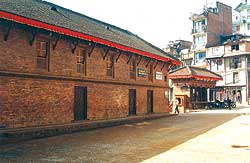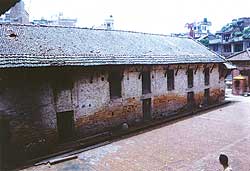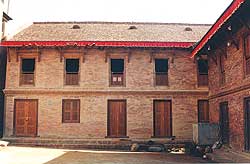

BEFORE AND AFTER: Two wings of the Chadaun Chapal Chhen in Chyasal Tole in Patan before and after restoration in 2001. ALL PICS: MUDITA BAJRACHARYA

At a time when the city cores of the Valley's town are seeing a revival of traditional architecture, some heritage conservationists are worried that new restoration techniques are not true to the original building designs.
In the centre of Patan, a 400-year-old street front building was torn down recently. It wasn't replaced with a modern glass and concrete block, but a modern five-story apartment with a brick fa?ade, tile brick roof, traditional carved windows and doors. Krishna Maharjan, the building's owner, is part of a new generation of house-owners at the forefront of a Newari architectural renaissance in Patan. But instead of being praised for his effort, he is getting criticism from conservationists who say it disturbs the harmony of the old town.
It is an age-old debate between how much compromise is too much in the struggle between heritage conservation and modern living. Should we be thankful that there is at least some respect for the past, or aim for a purity of form that may never be attainable?  Chapal Chhen at Chhaya Bahal was a 300-year-old guthi building in Patan in which the Jyapu Samaj conducted rituals and bhoj. The two-storey structure was falling apart and in 1999, the guthi decided to tear it down. In its place today is a five-storey building with a concrete skeleton and a traditional brick and tile fa?ade. The guthi rents the floors out to businesses, shops and functions to finance its festivals and other pujas.
Chapal Chhen at Chhaya Bahal was a 300-year-old guthi building in Patan in which the Jyapu Samaj conducted rituals and bhoj. The two-storey structure was falling apart and in 1999, the guthi decided to tear it down. In its place today is a five-storey building with a concrete skeleton and a traditional brick and tile fa?ade. The guthi rents the floors out to businesses, shops and functions to finance its festivals and other pujas.
Guthi member Babulal Maharjan brushes aside criticism that his new building is not in harmony with the city's old heart. "We have rebuilt it independently in a traditional style, and it is part of our effort to make the guthi self-sustaining so we don't have to depend on donations from guthiyars," he told us. "People should be glad that we didn't make it like a concrete box, we are true to our traditions."
Patan Mayor Buddhi Raj Bajracharya admits that some guthi buildings in his historic town are being demolished and the new structures are not rebuilt according to traditional designs or dimensions. But he adds: "We appreciate the collective effort of locals in Patan to preserve their traditional architecture, and we don't want to discourage that."
In Chyasal Tole, 300-year-old Tadaun Chapal guthi buildings belonging to the Byanjakar Samaj were demolished three years ago and the traditional mud and mortar buildings were replaced with modern structures. The reconstruction and designs were overseen by the German-aided Urban Development through Local Effort (UDLE) project. Many guthiyars donated money for the reconstruction, and locals contributed voluntary labour. The chairman of the Chyasal Tile Sudhar Samiti, Govinda Man Byanjakar justifies the restoration: "The previous structure was weak and used up a lot of space, we have changed the interior while keeping the exterior character of the buildings," he said. Indeed, there has been an effort to conserve the original brick masonry and retain the essence of Newari architecture in Chyasal.
The chairman of the Chyasal Tile Sudhar Samiti, Govinda Man Byanjakar justifies the restoration: "The previous structure was weak and used up a lot of space, we have changed the interior while keeping the exterior character of the buildings," he said. Indeed, there has been an effort to conserve the original brick masonry and retain the essence of Newari architecture in Chyasal.
But Jharana Joshi, a conservation officer with the Urban Management and Economic Diversification Project (UMEDP) doesn't agree. "It is a great loss to replace the Tadaun Chapal with a drastically different structure, it has altered the architectural history of the place."
In this tug-o'-war between conservation and modern architectural preservation, it is hard to say when the threshold of genuine heritage restoration has been crossed. And at a time when there is so much destruction going on, most town planners and architects are thankful that there is at least some sensitivity to the past, even if it is not 100 percent pure.
Heritage conservations need to balance the outside look with the changing lifestyles of house-owners and their need for modern interiors with higher ceilings, more light, more ventilation and better insulation against noise and heat.  Increasing economic pressure and the fragmentation of joint families have resulted in the vertical subdivision of houses, damaging their original character. In the absence of technical supervision, municipal oversight and the lack of subsidies for conservation, more and more houses are reconstructed rather than renovated.
Increasing economic pressure and the fragmentation of joint families have resulted in the vertical subdivision of houses, damaging their original character. In the absence of technical supervision, municipal oversight and the lack of subsidies for conservation, more and more houses are reconstructed rather than renovated.
Dilendra Raj Shrestha of Third World Guest House in Patan has renovated his neo-classical house, and says: "We must prioritise houses according to period and state of dilapidation and have a clear vision about what is realistically achievable." Shrestha has overseen the renovation of an old guthi house with help from UNESCO into a bed and breakfast pension in Patan that is true to the town's historical heritage. In future, this could be a sustainable model for income from heritage tourism to finance more restoration. At present, Patan's bylaws encourage the adoption of 'traditional Nepali style' but fail to explain what these are.
The overlapping responsibilities of the municipality, Department of Archaelogy, the Town Development Committee and the priorities of various donor-assisted projects have clashed in Patan, creating confusion. There is resistance to take responsibility and many urban house-owners simply use loopholes in the law to rebuild without any thought to conservation.  There is an added consideration: which historical period should restoration be true to? In restoring the Patan Durbar Square, for instance, does one go back to the pre-1934 earthquake, or restore the temples and buildings to the southern-European styles adopted by the Ranas with stucco window borders and venetian blinds? Purists scoff at Austrian architects who restored the eastern wing of the Patan Museum with visible steel beams to make the structure earthquake proof.
There is an added consideration: which historical period should restoration be true to? In restoring the Patan Durbar Square, for instance, does one go back to the pre-1934 earthquake, or restore the temples and buildings to the southern-European styles adopted by the Ranas with stucco window borders and venetian blinds? Purists scoff at Austrian architects who restored the eastern wing of the Patan Museum with visible steel beams to make the structure earthquake proof.
For Jharana Joshi at UMEDP, a model for true restoration should be like the rebuilding of the Ward 8 building. It is true to the original proportions, using the same local materials so that conservation does not become a caricature of the building that it replaced. Indeed, the Ward 8 building with the vegetation on its roof is an exact replica of the two-storey house it replaced, and is dwarfed by hideous concrete apartment blocks adjacent to it.  Joshi says traditional houses have their drawbacks: they are dark, damp, have low ceilings and leaky roofs. But many of these can be addressed with glass windows, damp-proof foundations and water-resistant roof tiles. "In addition, we can take advantage of the insulation properties of the thick walls with mud and mortar construction," she adds.
Joshi says traditional houses have their drawbacks: they are dark, damp, have low ceilings and leaky roofs. But many of these can be addressed with glass windows, damp-proof foundations and water-resistant roof tiles. "In addition, we can take advantage of the insulation properties of the thick walls with mud and mortar construction," she adds.
Ward 8 chairman, Prem Maharjan is happy with his building. "We nearly went for a cement building, because we thought it would be more durable, but decided on the brick face and traditional elements so that we could set an example for others about our heritage."


